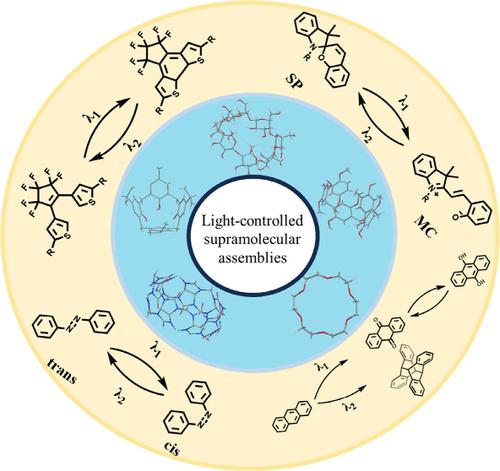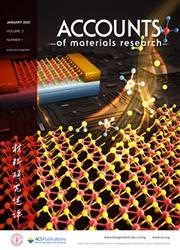Light-Controlled Macrocyclic Supramolecular Assemblies and Luminescent Behaviors
IF 14
Q1 CHEMISTRY, MULTIDISCIPLINARY
引用次数: 0
Abstract
Intelligent supramolecular assemblies can respond well to external stimuli such as pH, temperature, light, electricity, magnetism, and enzymes to achieve not only reversible topological morphology changes and assembly/disassembly processes but also special physical and chemical properties, which are successfully applied to biological imaging, cancer treatment, luminescent materials, anticounterfeiting, sensing, molecular switch in chemical, materials, as well as biological research fields. Among all stimuli-responsive supramolecular assemblies, light-controlled supramolecular assemblies have always attracted intense attention because light is a kind of clean and eco-friendly energy. In this Account, we focus on light-controlled supramolecular assemblies formed by four types of photoresponsive molecules and macrocyclic hosts such as cucurbit[n]urils, cyclodextrins, and crown ethers, and their regulations in luminescent materials and bioimaging. The assemblies and cascade assemblies between photoisomerization or photoreaction molecules and macrocyclic hosts mainly include: 1) light-controlled supramolecular assemblies based on macrocycles and diarylethene. As molecular switches, the open-ring and closed-ring configurations of diarylethenes can be reversibly controlled to achieve tunable fluorescence resonance energy transfer (FRET) process and further regulate luminescent behaviors to construct intelligent response cell-imaging, anticounterfeiting, and multicolor luminescence systems. 2) Light-controlled supramolecular assemblies based on macrocycles and spiropyran. Different from the diarylethenes, spiropyran can converse between positive charges in the ring-open merocyanie (MC) state, which is amphiphilic and easy to bond with macrocycles like cucurbit[n]urils, and neutral/negative charges in the ring-closed spiropyran (SP) state, which is more likely to self-assemble. Therefore, the differentiation of bonding affinities with macrocycles between MC and SP can achieve light-driven molecular machines. 3) Light-controlled supramolecular assemblies between macrocycles and azobenzene, whether azobenzene is modified to the macrocyclic hosts or functional guests, supramolecular assemblies are formed through host–guest interactions, and the topological morphology and luminescence behavior of the assemblies can be regulated by photoisomerization to apply in catalytic activity modulation, induction of microtubule (MT) assembly/disassembly, drug delivery, and others. 4) Light-controlled supramolecular assemblies based on macrocycles and anthracene, in which different bonding affinities between anthracene before and after photooxidation and macrocyclic hosts, as well as reversible dimerization, not only change the topological morphologies but also drive fluorescence phosphorescence dual imaging and the construction of photostimuli-driven luminescent lanthanide molecular switch. With the creation of macrocycles with novel building units and different modifications of photoresponsive molecules, we consider that the innovation and growth of light-controlled intelligent supramolecular materials should be more widely used in tunable material topological morphology conversion, real-time cell imaging, targeted drug delivery, organic optoelectronic materials, molecular machines, and photocatalysis reactions.

光控大环超分子组装和发光行为
智能超分子组装体能够很好地响应 pH 值、温度、光、电、磁和酶等外部刺激,不仅能实现可逆的拓扑形态变化和组装/拆卸过程,还能实现特殊的物理和化学特性,被成功应用于生物成像、癌症治疗、发光材料、防伪、传感、分子开关等化学、材料和生物研究领域。在所有刺激响应超分子组装体中,光控超分子组装体一直备受关注,因为光是一种清洁环保的能源。在本开户绑定手机领体验金中,我们重点研究了四种光响应分子与葫芦烯、环糊精和冠醚等大环宿主形成的光控超分子组装体及其在发光材料和生物成像中的应用。光异构化或光反应分子与大环宿主之间的组装和级联组装主要包括1)基于大环和二元乙烯的光控超分子组装。作为分子开关,可以可逆地控制二元乙烯的开环和闭环构型,实现可调的荧光共振能量转移(FRET)过程,并进一步调节发光行为,构建智能响应的细胞成像、防伪和多色发光系统。2) 基于大环和螺吡喃的光控超分子组装。与二元烯类不同,螺吡喃可以在环开的梅洛拉尼(MC)态和环闭的螺吡喃(SP)态之间转换,前者带正电荷,具有两亲性,容易与葫芦[n]脲等大环结合;后者带中性/负电荷,更容易自组装。因此,区分 MC 和 SP 与大环的键合亲和力可以实现光驱动分子机器。3) 光控大环与偶氮苯之间的超分子组装,无论是偶氮苯修饰为大环宿主还是功能客体,都会通过宿主-客体相互作用形成超分子组装体,组装体的拓扑形态和发光行为可通过光异构化进行调控,从而应用于催化活性调控、诱导微管(MT)组装/解组装、药物递送等领域。4) 基于大环和蒽的光控超分子组装体,蒽在光氧化前后与大环宿主之间不同的键合亲和力以及可逆的二聚化,不仅改变了拓扑形态,还驱动了荧光磷光双重成像,并构建了光刺激驱动的发光镧系元素分子开关。我们认为,随着具有新颖构建单元的大环的产生和光致分子的不同修饰,光控智能超分子材料的创新和发展应更广泛地应用于可调材料拓扑形貌转换、实时细胞成像、靶向药物递送、有机光电材料、分子机器和光催化反应等领域。
本文章由计算机程序翻译,如有差异,请以英文原文为准。
求助全文
约1分钟内获得全文
求助全文

 求助内容:
求助内容: 应助结果提醒方式:
应助结果提醒方式:


